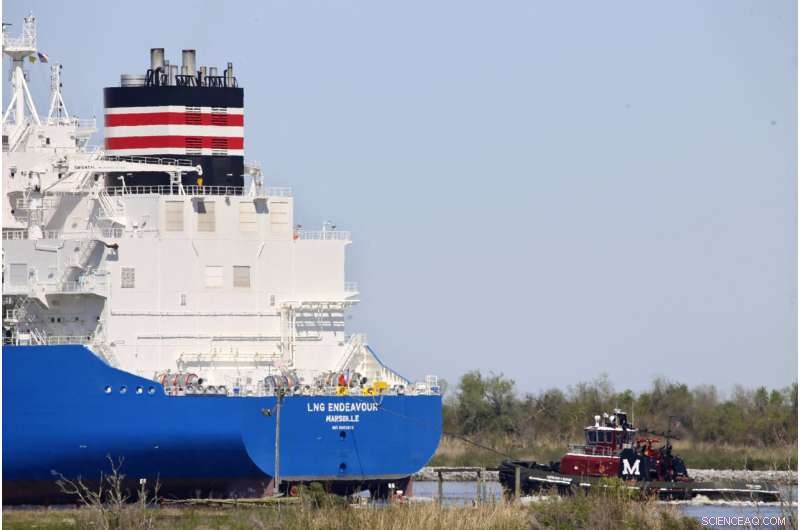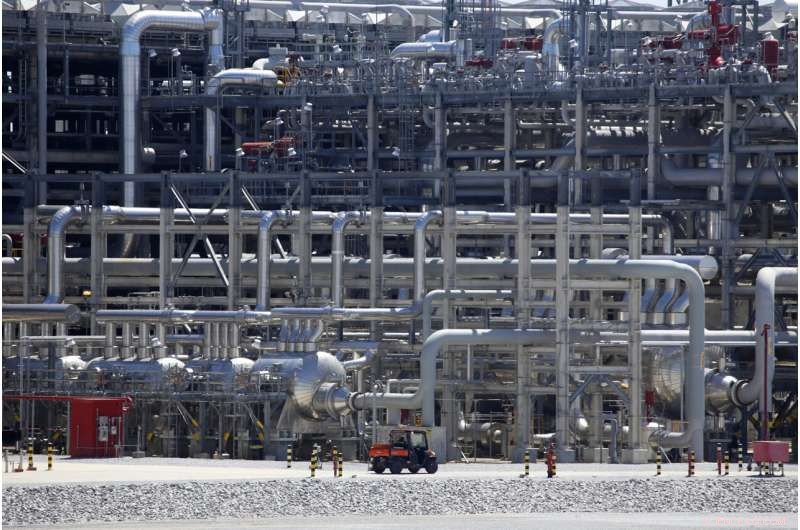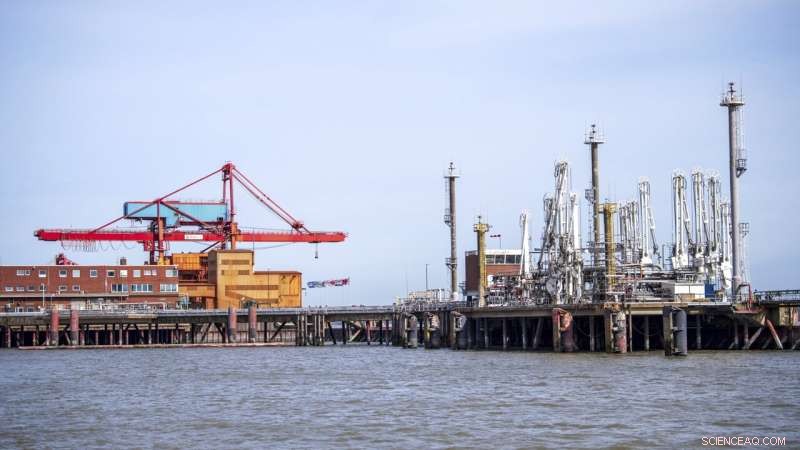
Un rimorchiatore aiuta a guidare una nave francese, nota come LNG Endeavour, attraverso il lago Calcasieu vicino a Hackberry, La., il 31 marzo 2022. La guerra della Russia contro l'Ucraina ha infranto le sue relazioni con l'Europa, che ha presto perso la maggior parte del gas naturale che Mosca aveva a lungo fornito. Ora, con l'avvicinarsi dell'inverno, le nazioni europee hanno sostenuto una soluzione a breve termine che inizierà entro la fine del 2022 che ha sollevato allarmi tra gli scienziati che temono le conseguenze a lungo termine per il clima. Credito:AP Photo/Martha Irvine, File
Con l'avvicinarsi dell'inverno, le nazioni europee, alla disperata ricerca di sostituire il gas naturale che una volta avevano acquistato dalla Russia, hanno adottato una soluzione a breve termine:una serie di circa 20 terminali galleggianti che riceverebbero gas naturale liquefatto da altri paesi e lo convertirebbero in combustibile per riscaldamento.
Eppure il piano, con i primi terminali galleggianti destinati a fornire gas naturale entro la fine dell'anno, ha sollevato allarmi gli scienziati che temono le conseguenze a lungo termine per l'ambiente. Avvertono che questi terminali perpetuerebbero la dipendenza dell'Europa dal gas naturale, che rilascia metano e anidride carbonica che riscaldano il clima quando viene prodotto, trasportato e bruciato.
Alcuni scienziati affermano di temere che i terminali galleggianti finiranno per diventare un fornitore a lungo termine del vasto fabbisogno energetico dell'Europa che potrebbe durare anni, se non decenni. Una tale tendenza potrebbe frenare gli sforzi di riduzione delle emissioni che, secondo gli esperti, non si sono mossi abbastanza velocemente da rallentare i danni arrecati all'ambiente globale.
Gran parte del gas naturale liquefatto, o GNL, che l'Europa spera di ricevere dovrebbe provenire dagli Stati Uniti. La necessità è sorta dopo che l'invasione russa dell'Ucraina ha infranto i suoi legami con l'Europa e ha portato a un'interruzione della maggior parte del gas naturale che Mosca aveva fornito da tempo. Lungo la costa del Golfo degli Stati Uniti, i terminali di esportazione si stanno espandendo e molti residenti sono allarmati per l'aumento delle trivellazioni per il gas e la conseguente perdita di terra, nonché per i cambiamenti meteorologici estremi associati alla combustione di combustibili fossili.
"La costruzione di questa immensa infrastruttura GNL bloccherà il mondo nella continua dipendenza dai combustibili fossili e nei continui danni climatici per i decenni a venire", ha affermato John Sterman, scienziato del clima presso il Massachusetts Institute of Technology.
Il gas naturale contribuisce in modo significativo al cambiamento climatico, sia quando viene bruciato, trasformandosi in anidride carbonica, sia attraverso perdite di metano, un gas serra ancora più potente. Eppure le nazioni europee, che da anni sono leader nel passaggio a un'energia più pulita, hanno proposto di portare più di 20 terminali GNL galleggianti nei loro porti per aiutare a compensare la perdita di gas naturale russo.
I terminal, che sovrastano le case e si estendono per quasi 304 metri, possono immagazzinare circa 6 miliardi di piedi cubi (170.000 metri cubi) di GNL e convertirlo in gas per case e aziende. Possono essere costruiti più velocemente ed in modo più economico rispetto ai terminali di importazione a terra, anche se sono più costosi da gestire, secondo l'International Gas Union.
"Ogni paese deve prepararsi a uno scenario in cui potrebbe esserci un taglio delle forniture russe", ha affermato Nikoline Bromander, analista di Rystad Energy. "Se sei dipendente, devi avere un piano di riserva."

A flare burns at Venture Global LNG in Cameron, La., on April 21, 2022. Russia’s war against Ukraine shattered its relations with Europe, which soon lost most of the natural gas that Moscow had long provided. Now, as winter nears, European nations have backed a short-term fix set to begin before the end of 2022 that has raised alarms among scientists who fear the long term consequences for the climate.Credit:AP Photo/Martha Irvine, File
Many environmental scientists argue that the money being earmarked for the ships—which cost about $500 million each to build, according to Rystad—would be better spent on rapidly adopting clean-energy or efficiency upgrades that could reduce energy consumption.
Constructing more solar or wind farms, which takes years, wouldn't immediately replace Russian gas. But with adequate funding, Sterman suggested, greater energy efficiencies—in homes, buildings and factories, along with the deployment of wind, solar and other technologies—could vastly reduce Europe's need to replace all the gas it's lost.
Germany, among Europe's strongest advocates for the floating LNG terminals, is expecting five of the ships and has committed roughly 3 billion euros to the effort, according to Global Energy Monitor. Germany has also approved a law to fast-track the terminals' development, suspending the requirement for environmental assessments.
It's a move that troubles environmental groups.
"It's totally obvious," asserted Sascha Müller-Kraenner, CEO of Environmental Action Germany, that "the provisions of the law were developed in close dialogue with the gas industry."
Germany's government and energy industry have defended their embrace of the LNG terminals as an urgent response to the loss of most of the Russian gas they had long received, which they fear Moscow will shut off completely.
"In an exceptional situation such as this, where it's a matter of Germany's gas supply security, it is justified to accelerate the approval process," Germany's energy industry association, BDEW, said in a statement.
Susanne Ungrad, a spokeswoman for Germany's Economy and Energy Ministry, noted that efforts are being made to lower methane emissions in exporting countries like the United States. And she said that in pursuing the construction of LNG terminals, Europe authorities will conduct comprehensive assessments.

A small vehicle drives past a network of piping that makes up pieces of a "train" at Cameron LNG export facility in Hackberry, La., on March 31, 2022. Russia’s war against Ukraine shattered its relations with Europe, which soon lost most of the natural gas that Moscow had long provided. Now, as winter nears, European nations have backed a short-term fix set to begin before the end of 2022 that has raised alarms among scientists who fear the long term consequences for the climate. Credito:AP Photo/Martha Irvine, File
Greig Aitken, an analyst at Global Energy Monitor, noted that a terminal that's set to open near Gdansk, Poland, has signed contracts with American LNG suppliers that extend well past 2030. That could make it problematic for the European Union to meet its goal of reducing greenhouse gas emissions by at least 55% by 2030.
Italy, Greece, France, the Netherlands, Croatia, Estonia, Finland, Latvia, Slovenia and the U.K. all have one or more floating LNG terminals planned, according to Rystad Energy.
In some cases, proponents argue, the ships could aid the environmental cause. They note, for example, that as Russian gas supplies have dwindled, communities in Germany and elsewhere have been burning coal, which typically produces more emissions than natural gas. Increasing the supply of natural gas would make this less necessary.
Still, methane can frequently leak along the natural gas supply chain. So in some cases, the net climate effect of burning natural gas may be no better than coal.
The U.N. Intergovernmental Panel on Climate Change has warned that continuing to use the fossil fuel infrastructure already in place would cause global warming to exceed 1.5 degrees Celsius (2.7 Fahrenheit). At that level, heat would be expected to worsen the flash floods, extreme heat, intense hurricanes and longer-burning wildfires that have resulted from climate change and have cost lives.
"It is a little disheartening to see Europe, which has been the seat of so much energy and action and bold emissions targets, being home to this particular way with doubling down on fossil fuel infrastructure," said Kim Cobb, a climate scientist at Brown University.
In the United States, the largest export market for Europe-bound LNG, three new export terminals are under construction. Eleven additional terminals and four expansions are in the planning stages. Some export terminals that had struggled to attract financing are now seeing more investment and interest, said Ira Joseph, a longtime energy analyst.
"What you've seen happen over the last two months—they're signing up sales and purchase agreements, right and left," Joseph said.

The area in front of the Stade Industrial Park is part of the future port expansion for the planned import terminal for liquefied natural gas (LNG) in Stade, Germany, on April 2022. Russia’s war against Ukraine shattered its relations with Europe, which soon lost most of the natural gas that Moscow had long provided. Now, as winter nears, European nations have backed a short-term fix set to begin before the end of 2022 that has raised alarms among scientists who fear the long term consequences for the climate. Credit:Sina Schuldt/dpa via AP, File
Rio Grande LNG, an export terminal proposed by Next Decade in Brownsville, Texas, for example, appeared to stall last year in the face of environmental protests. But this spring, a French company, Engie, and several clients in Asia signed long-term contracts to buy LNG from the terminal. Now, Next Decade says it's likely to obtain all the financing it needs.
Europe's gas scarcity has escalated global LNG prices, leading buyers in China and elsewhere to sign long-term contracts with suppliers in the United States. American LNG exports will likely grow by 10 million tons over the next year, said Bromander, the Rystad analyst.
The floating LNG ships have been billed as a short-term solution to keep gas flowing for a few years while cleaner energy sources like wind and solar are built up. But critics say it's unlikely that a ship built to last decades would permanently halt operations after a few years.
Once the floating terminals are built, they can be used anywhere in the world. So if European nations no longer want floating LNG terminals as they transition to cleaner energy, the ships could sail off to another port, essentially locking in the use of natural gas for decades.
And in some cases, particularly in Germany, some of the proposed floating terminals appear to be paving the way for on-shore terminals that would be built to last 30 or 40 years—well past the point that nations should be burning fossil fuels, environmental groups say.
"After the war is resolved and, as we all hope, peace is restored, are they really going to say, 'Oh, let's take it to the scrap yard?,'" Sterman asked. "They're not going to do that." + Esplora ulteriormente
© 2022 Associated Press. Tutti i diritti riservati. Questo materiale non può essere pubblicato, trasmesso, riscritto o ridistribuito senza autorizzazione.